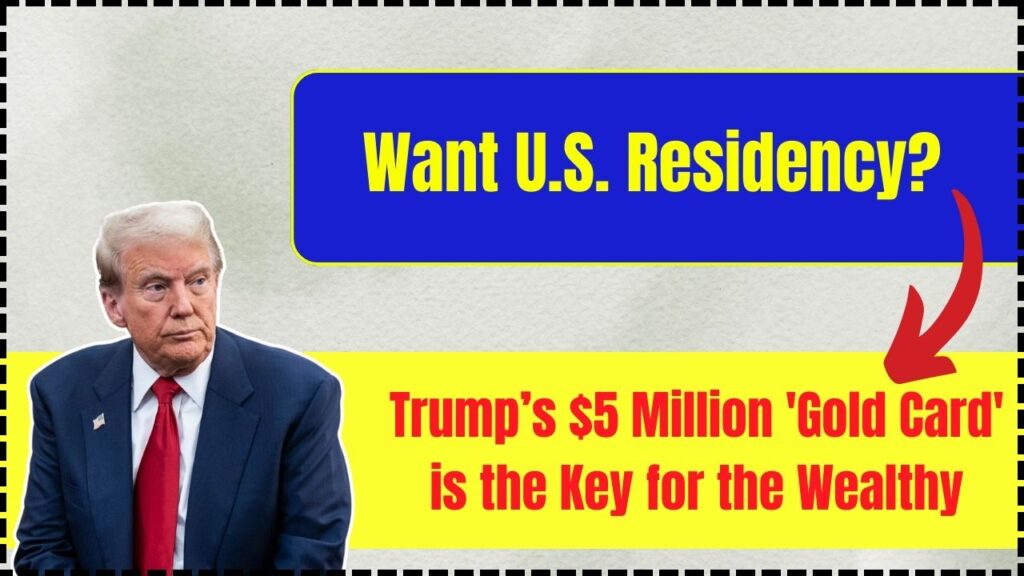Want U.S. Residency: In a bold move set to shake up U.S. immigration policy, President Donald Trump has introduced a proposal that offers ultra-wealthy foreigners a new path to U.S. residency and citizenship through the purchase of a Gold Card. This program, which requires a $5 million investment, is designed to replace the traditional EB-5 visa program. In this article, we break down what Trump’s Gold Card is, how it compares to the EB-5 visa, and what this means for potential investors, employers, and the overall U.S. economy.

The concept behind the Gold Card is straightforward: by paying a hefty fee of $5 million, high-net-worth individuals can secure permanent residency status and eventually gain citizenship. Although the idea might sound like something from a futuristic movie, it is grounded in recent policy shifts and aims to boost economic growth by attracting significant investment. In the following sections, we will explore the details of the proposal, the potential benefits, and some challenges it may face.
Want U.S. Residency?
| Aspect | Details |
|---|---|
| Program Name | Gold Card Visa |
| Investment Requirement | $5 Million |
| Replacement For | EB-5 Investor Visa (requires $800K to $1.05M plus job creation criteria) |
| Target Audience | Ultra-wealthy individuals, including top-tier global citizens and potential Russian oligarchs |
| Economic Impact Claim | Potential to raise significant revenue to help reduce national debt (theoretical projection of selling up to a million cards generating $5 trillion) |
| Key Benefits | Permanent residency, eventual path to citizenship, and a boost to U.S. economic growth |
For more detailed information, visit the official USCIS EB-5 page.
Understanding the Gold Card Visa
What Is the Gold Card Visa?
The Gold Card visa is a proposed residency program that allows foreigners to secure U.S. permanent residency by making a one-time payment of $5 million directly to the U.S. government. Once granted, the card provides the holder with rights similar to those of a green card, including the ability to live and work in the United States and eventually apply for citizenship. The program is positioned as a simpler and more streamlined alternative to the current EB-5 visa.
Why Replace the EB-5 Visa?
The current EB-5 visa program has been a popular route for investors since its inception. Under this program, an individual must invest between $800,000 and $1.05 million in a U.S. business that creates or preserves at least 10 jobs for American workers. However, the EB-5 program has been criticized for its complexity and susceptibility to fraud. Critics argue that the program can sometimes benefit connected businesses and lacks stringent oversight.
Trump’s administration has characterized the EB-5 system as “full of nonsense, make-believe, and fraud,” proposing the Gold Card as a cleaner, more direct method of channeling funds into the economy. By setting a higher investment threshold, the Gold Card seeks to attract truly affluent investors who are expected to spend, invest, and create jobs in the U.S.
How Does the Gold Card Differ?
- Investment Amount:
The most striking difference is the investment requirement. The EB-5 visa requires an investment of around $800,000 to $1.05 million—primarily focused on job creation—while the Gold Card sets the bar at $5 million, a figure that signifies a commitment to making a substantial financial contribution. - Job Creation:
Unlike the EB-5, the Gold Card does not explicitly require the creation or preservation of jobs. The emphasis is purely on the investor’s wealth and the immediate cash infusion into the government’s coffers. - Speed and Simplicity:
With fewer procedural hurdles, the Gold Card could potentially offer a faster track to residency for those who qualify, reducing bureaucratic delays and complexities that have long plagued the EB-5 process.
The Economic and Social Implications
Economic Impact
One of the most touted benefits of the Gold Card program is its potential to provide a substantial revenue stream for the U.S. government. President Trump has suggested that if the program were to attract up to a million investors, it could generate as much as $5 trillion in revenue—a figure that, if realized, could theoretically be used to pay down the national debt. While such projections are optimistic and largely theoretical, they underscore the administration’s commitment to using immigration policy as a tool for fiscal strategy.
However, it is important to note that similar “golden visa” programs in other countries (such as those in the U.K. and Australia) have historically attracted only a few hundred applicants per year. This discrepancy raises questions about whether the market will indeed support such an ambitious initiative. For further insights on international golden visa programs, visit the U.K. Golden Visa scheme.
Social and Political Considerations
The introduction of the Gold Card program has sparked considerable debate. On one hand, proponents argue that by attracting ultra-wealthy investors, the U.S. could see a boost in economic activity as these individuals invest in businesses, pay taxes, and create jobs. On the other hand, critics are concerned that the program could be seen as a way for the rich to “buy” their way into the country, potentially undermining the principles of fairness in immigration policy.
Additionally, questions about security, vetted eligibility, and the potential for corruption have been raised. The program’s emphasis on wealth rather than tangible contributions like job creation might invite scrutiny regarding how investments are verified and how the funds are utilized once collected. For reliable updates on immigration policy and fraud prevention, check the official U.S. Department of Homeland Security website.
Impact on Industries and Global Talent
Another dimension to consider is how the Gold Card might affect various industries and the global talent market. For sectors such as technology, healthcare, and engineering, the program is unlikely to address talent shortages directly since it is not designed for skilled professionals who require sponsorship through employment-based visas like the H-1B or O-1 programs. Instead, the Gold Card is intended for investors—individuals whose primary contribution is financial rather than intellectual or technical.
This shift could alter the perception of the U.S. in the global talent market. While many other countries offer more accessible pathways for skilled workers, the Gold Card emphasizes wealth over expertise, which might reduce the inflow of talented professionals. Employers facing talent shortages may need to continue relying on traditional visa channels or look for alternative strategies, such as global recruitment and remote work arrangements.
Detailed Guide: Navigating the Gold Card Proposal
Step 1: Research and Understand the Basics
Begin by familiarizing yourself with both the current EB-5 visa program and the proposed Gold Card initiative. Understand the investment requirements, benefits, and responsibilities associated with each. Reliable sources include:
- USCIS EB-5 Visa Overview
- Reuters Immigration Coverage
Step 2: Evaluate Your Eligibility
Assess whether you or your organization meets the criteria for the Gold Card program. This program is designed for high-net-worth individuals who can commit $5 million. It is crucial to consult with an immigration attorney to review your financial status and understand the long-term implications of such an investment.
Step 3: Understand the Legal Landscape
Since the Gold Card proposal represents a significant shift from traditional immigration policy, staying updated on legislative developments is crucial. Monitor news from high-authority outlets such as CNN and Forbes, and refer to official government resources for the latest updates.
Step 4: Consult with Experts
Given the complexity of immigration law and the high stakes involved, professional advice is essential. Engage with experienced immigration attorneys and financial advisors who can help you navigate the nuances of the program. Websites like Boundless Immigration offer resources and expert consultations.
Step 5: Plan for the Long-Term
Consider the Gold Card not just as an investment in immigration status but as part of your broader economic strategy. Evaluate how this move fits into your long-term personal or corporate financial planning. Factor in tax implications, residency obligations, and future citizenship prospects.
Step 6: Stay Informed
The immigration landscape is ever-changing. Keep track of policy updates, public debates, and expert analyses. Being well-informed will help you make timely and effective decisions. Reliable sources include Reuters, AP News, and the official U.S. Department of Homeland Security.
Additional Insights and Global Comparisons of U.S. Residency
Lessons from International Programs
Many countries around the world have implemented golden visa programs to attract wealthy investors. For example:
- Portugal: Offers residency permits in exchange for property investments, with thousands of successful applications each year.
- Spain and Greece: Have similar programs that have boosted their real estate markets and tourism sectors.
Comparing these international programs with the proposed U.S. Gold Card can offer insights into potential market demand and operational challenges. While the U.K. and Australia have seen modest numbers, the U.S. market—given its global economic standing—could behave differently. For more details on international golden visas, refer to the European Commission’s investment immigration policy page.
Potential Challenges and Criticisms
Despite its ambitious goals, the Gold Card proposal is not without challenges:
- Market Demand: There is skepticism about whether there are enough ultra-wealthy individuals willing to commit $5 million solely for residency, especially when other countries offer more accessible options.
- Legal Hurdles: Critics argue that replacing the EB-5 program with the Gold Card might face legal challenges, as changes in immigration policy typically require Congressional approval and must adhere to existing laws.
- Security and Vetting: Ensuring that applicants are thoroughly vetted to prevent fraud and misuse of the system will be critical. High standards must be maintained to avoid any compromise on national security.
- Perception and Fairness: The program may be perceived as elitist, creating a divide between those who can afford such privileges and those who cannot. This raises broader questions about fairness in immigration policy.
Real-World Examples and Expert Opinions
Several experts have shared their opinions on the potential impact of the Gold Card. For instance, immigration attorney Michael Wildes has noted that while the proposal could simplify processes for wealthy investors, it might also lead to an influx of capital without corresponding job creation—a key element in traditional investment-based immigration. Similarly, financial analysts have highlighted the potential for the program to inject significant funds into the U.S. economy, even if only a fraction of the projected number of investors participate.
USA $200 Prepaid Debit Cards for Social Security Retirement in 2025 – How to claim it? Check Process
$1000 Universal Basic Income (UBI) in the USA: Eligibility, Application, and Payment Dates
FAQs About Want U.S. Residency?
Q1: What is the Gold Card Visa?
The Gold Card Visa is a proposed U.S. residency program that allows ultra-wealthy individuals to secure permanent residency by investing $5 million. It aims to replace the EB-5 investor visa program.
Q2: How does the Gold Card differ from the EB-5 visa?
Unlike the EB-5 visa—which requires a lower investment and mandates job creation—the Gold Card focuses solely on a $5 million investment and does not explicitly require the creation of jobs.
Q3: Who is eligible for the Gold Card Visa?
The program targets high-net-worth individuals who can afford the $5 million investment and are considered “world-class global citizens” through a stringent vetting process.
Q4: What are the potential benefits of the Gold Card?
Benefits include faster processing times, a straightforward path to U.S. residency, eventual citizenship, and a potential boost to the U.S. economy by injecting substantial capital.
Q5: Are there any risks or challenges associated with the Gold Card?
Yes, risks include legal challenges, uncertainties about market demand, potential security concerns, and questions regarding fairness in immigration policy.
Q6: Where can I find more information?
For further details, refer to reliable sources such as the USCIS EB-5 page, Reuters, and the U.S. Department of Homeland Security.








